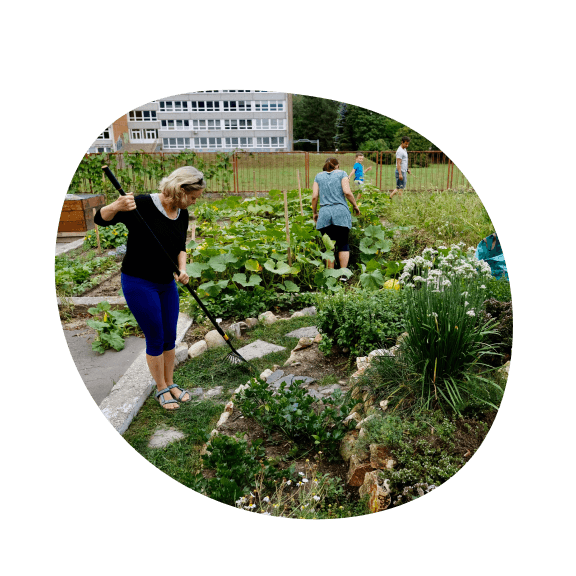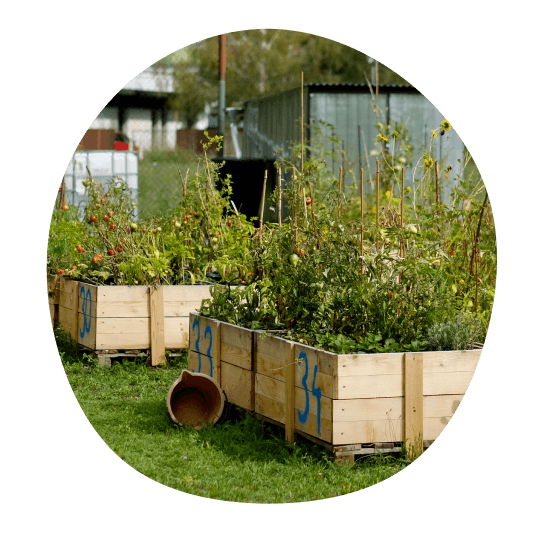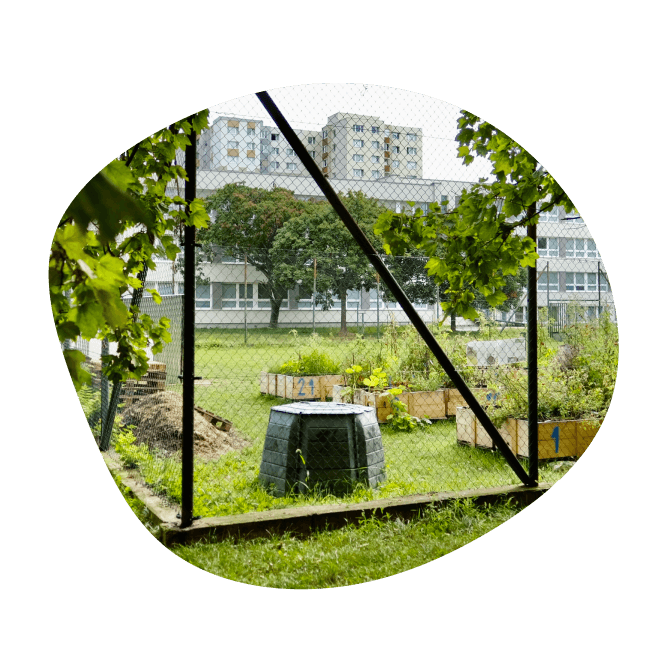Community Gardens
The community garden is a place for active neighbourhood life. Gardening serves as a tool for both connecting and educating, for creating an open and safe shared space. What's more, you can organise events in the garden, from birthday parties and barbecues to exhibitions and theatre plays.
Learn how to reach out to people and create a civic association with your neighbours, as well as what you should consider when planning and financing your garden and choosing a plot of land.

At the heart of every community are the people
The foundation of any community garden is its enthusiastic users. One of the first steps should be to reach out to the neighbourhood in which you are planning to establish the community garden. Meet, get to know each other, find out what motivations and skills you have and plan your next steps together.
- They are passionate about green issues. They are local activists. They like to organise and socialise.
- They have time - students, people on maternity or paternity leave, freelancers, elderly neighbours.
- Neighbours who are keen gardeners. You may not even know just how many landscape architects or hobby gardeners you have around you.
Our tip: The ideal is to have at least three or four people on the team, each of whom has a personal interest in the creation of the garden and the capacity they are willing to invest in the work, and some social connections in the neighbourhood. Simple leaflets are a great way of contacting your neighbours, many of whom are likely to be fellow gardeners.
After approaching your neighbours, you need to set up a civic association
In order to lease the land, it is necessary for those interested in a community garden on city land to form a civic association. This will give you legal status and allow you to apply for a wide range of grants that are available throughout the year from a variety of organisations and companies, including the City.
A minimum of three persons, at least one of whom must be over 18 years of age, need to submit an application for registration of a civil association. The proposal must include details of the association's statutory body and who is the proxy authorised to act on their behalf. It is also necessary to attach the statutes of the civic association in duplicate.
Registration of the association is subject to a fee of 66€, with an electronic filing fee of 33€.
Some of the necessary documents can be found in the Downloads section. All information on the establishment of a civic association can be found on the website of the Ministry of the Interior of the Slovak Republic ↗︎.
After establishment of the civil association, it is also necessary to set up a bank account. A transparent account appears to be an acceptable and suitable form, as you will be handling money from your members, volunteers, foundation sponsors, etc. Some banks provide this account free of charge.
Throughout the functioning of the civic association, it is necessary to keep all receipts and record expenditures due to the need for bookkeeping and a possible retrospective check (this is especially true for grants received).

City graphic designer advises on what to put in the leaflets
The city's graphic designer has prepared a downloadable poster that you can use to reach out to your neighbours. You can download the template and edit the text. If you want to create your own leaflet, the city graphic designer has also prepared basic advice for you.
"The important thing is to keep it simple and clear, use one typeface, don't combine multiple fonts. A bold font for the title and a bold font for the body of the text are more suitable. The headline is important: it must be short, as large as possible and must summarise the idea. It should address an activity – we plan or want to create."
"Another important thing is to put a contact to which neighbours can go, and the poster should not contain a lot of text. I also recommend using the link where you can read all about community gardens or your intention in the calm of your own home. Don't use unnecessary logos and abbreviations − you are addressing your neighbours. Be friendly and freely introduce yourself. A community garden is a place you can create together with the help of your neighbours."
Download
- Editable poster. You can download the template and edit the text. (in SK)03. 03. 2022 • DOCX • 490 kB
The beginning of all activities is identifying the garden’s location
- 1
Are there people living nearby who would use the garden? Is the place safe? Will natural social control of space be possible? Do a lot of people walk close to the place or will the garden be rather isolated? Compact parts of the city and proximity to residential houses are preferable to dispersed areas on the edges of housing estates, surrounded by, for example, shopping centres.
- 2
What is on the property? However, it is important to remember that hardy, undemanding and non-invasive species are required that can withstand even the harshest urban conditions.
- 3
Is the land polluted? Were or are there hazardous chemicals or other contamination on the property? Emissions from traffic or noise? Land close to busy roads is not very suitable.
- 4
Is the area sunny? Windy? How is it shaded by the surrounding buildings? Will it be possible to create shade from harsh summer sun?
- 5
What is the soil quality? If a permanent garden is possible, the quality of the soil can be determined by laboratory tests. If there is a hard surface or rubble on the land, fertile soil will need to be imported, or just cultivation in pots might be advisable.
- 6
Where would we get water from? Is the plot adjacent to a building with whose owner water access could be negotiated? Are there roofs in direct contact that could collect rainwater? Alternatively, is there a water connection directly on the property? Or is it possible to site a water tank there?
- 7
Who owns the land? Ideal locations are unused premises without prospect of early use which are owned by the city or city district. You can discover the owner via the cadastral portal or even easier via ZBGIS ↗︎.
Should we choose a mobile or a permanent community garden?
Depending on the nature of the land, decide whether a permanent community garden that can be used as a garden for the long-term is suitable, or whether the land is only temporarily available and a "mobile garden" would be more appropriate, where the entire infrastructure is relocatable and can be easily moved if the condition of the land changes.
Mobile gardens are an activity, not a building. All the infrastructure is relocatable, i.e. no foundations are built in the garden area, no wells are drilled, and the terrain of the property is not significantly altered. Accordingly, their allocation does not require planning permission from the local building authority.

Our tip: A mobile garden is an ideal solution for all those locations that are available at present but where their future is questionable - when will the private owner get planning permission? When will the complex ownership situation be settled? When will the restitution seal be resolved? When will the local government have the resources to fund the revitalisation project? When will the school implement the plan to revitalise the sports field? A permanent garden is, of course, better. However, it is not easy to find the location for it.

Fencing
Safety and security of property is important at all community venues. Depending on the specific plot and the intensity of social control, it is essential to consider what fencing is needed. If the garden is located in an enclosed courtyard, there is no need for fencing. In some cases, for example, a low wooden fence (height 1.2m) is sufficient. Mesh fencing up to a height of 2m is the safest. Implementation of fencing can be done on your own or commissioned to a skilled craftsman.
Fencing is defined by law as a minor construction and so does not require a building permit. However, it is necessary to report this construction to the building authority. The building authority will send you an opinion within 15 days. If it is only the reconstruction of an old fence, no notification is required. If the total height of the fence is more than 2 metres, you must obtain planning permission from the building authority.
It is practical to lock the gate with a padlock with a numerical code that all the gardeners will know.
Urban land versus own land proposal
Urban land from the offer
- Pre-approved urban land
- Faster application processing
- Support from our urban greening experts
Custom land design
- Necessity to identify the owner and manager of the land
- Assessment of specialist departments required
- More lengthy application processing
Conditions of certain urban lands
In order to ensure a quality public space for all its users, we have prepared some conditions for the creation of a community garden on some of the urban lands on offer. Lands that are required to meet this condition have it stated in the land information on the listing and map. The total area of the beds on these lands shall not exceed 50 m². The total area of occupied public space must not exceed 200 m² (150 m² handling area + 50 m² flower bed area). Raised beds shall be at least 2.5 m from the base of the trunk of the nearest tree.
There are easements on some of the city lots in the offering. Most of the time, this is an easement from the power station or utility company. This means that it is necessary to take this into consideration when designing the garden, and leave, for example, a reserve in the space for the company's technicians who will need access to this easement. The easement on the land in no way extends the processing time for a community garden application on the selected parcel.
Our tip: We recommend you to choose one of the urban lands. If you wish to propose a different plot of land, the landowner must approve the location of the garden, which may increase the processing time of your application.
Manuals and documents to download
Important documents needed when setting up a community garden and a civic association. Further templates and documents can be found on the website of the Ministry of the Interior of the Slovak Republic ↗︎.
Manuals and documents
- Sample lease agreement (in SK)27. 04. 2022 • DOCX • 47.9 kB
- Poster, through which you can reach your neighbors (in SK)27. 04. 2022 • DOCX • 490 kB
Frequently asked questions
How large an area of garden can be claimed for a plot that does not have a specified garden size?
In the case of a plot where colleagues from the urban greening department have not defined the size of the garden, the residents will propose the size and the professional departments will assess whether it can be of that size. On selected lands, we want to give people the opportunity to choose the location and size of their garden. In the same way, some of the larger lands may allow for the implementation of a community garden and some other revitalisation, embellishment of the area. Thus, one part of it can be used by the community tending the garden and the other by all residents.
What can help in determining your area?
If you use mobile boxes, roughly 1 box = 1x2m². If you have patches, one patch is approximately 4 m². Based on this data, you can plan and plot your garden layout.
Is it possible to determine the type and quality of the subsoil?
Consultation with our urban greening department is possible. If you are concerned about the subsoil, it is advisable to choose a mobile garden i.e. raised beds (boxes). If a permanent garden is possible, the quality of the soil can be determined by laboratory tests. If there is a hard surface or rubble on the land, fertile soil will need to be imported or only cultivation in plant pots might be suitable.
How will the city proceed if several civic associations are interested in the land at the same time?
All applications are considered separately. In the event of a situation where, for example, two different civic associations apply for the same plot of land, the association that applied first will get the land (if it fulfils the requirements for the lease). However, with the consent of the residents, we would try to bring people with an interest in the same plot of land together to create, at best, an even larger community of people.